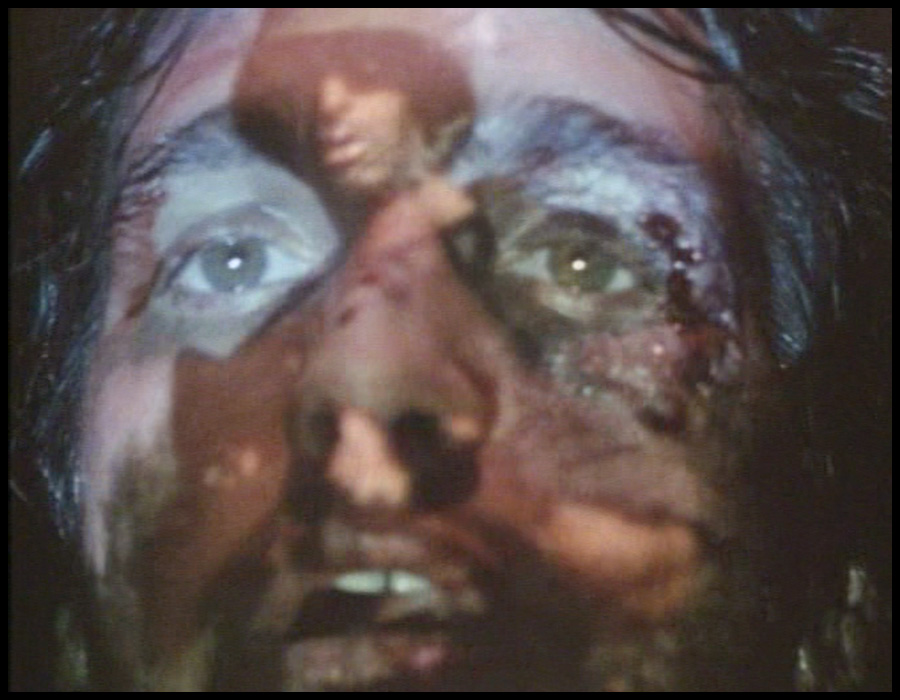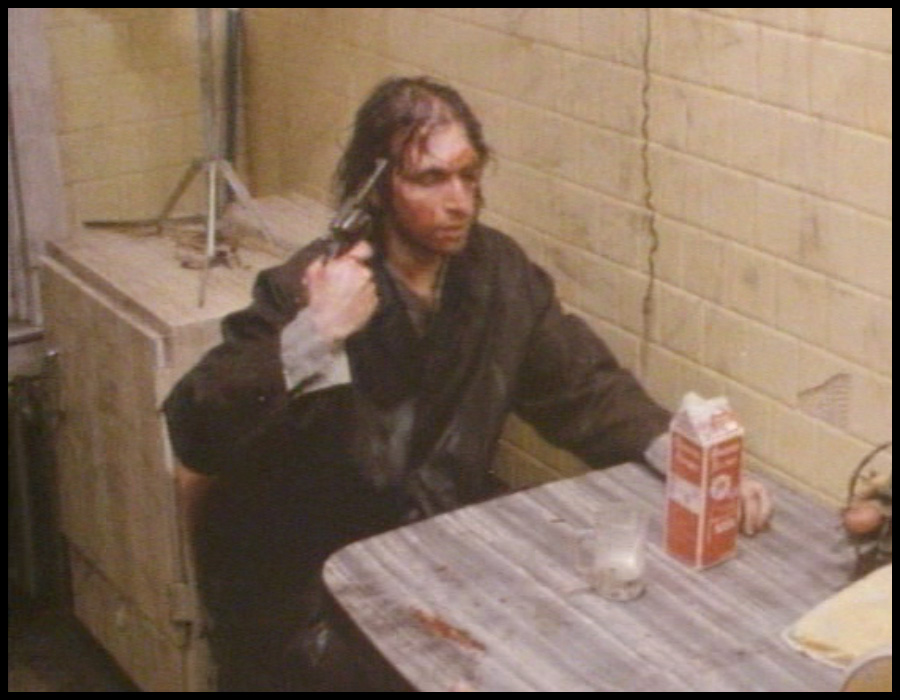|
COMBAT SHOCK (1986).
 Combining the New York City angst of TAXI DRIVER, the gritty nihilism of Fassbinder and the unfiltered dementia of ERASERHEAD, director-writer-producer Buddy Giovinazzo's COMBAT SHOCK is the type of distinctly personal (not to mention, severely deranged) project that only Lloyd Kaufman, Michael Herz and The Troma Team would have the guts to distribute. Originally entitled AMERICAN NIGHTMARES, this mindroasting indie made its theatrical debut in 1986, when it played on Times Square (in a gutted, R-rated version, in order to placate the corporate-ass-kissing M.P.A.A.) at the long-defunct U.A. Twin on Broadway and 49th Street. Unfortunately, I missed that brief window to see COMBAT SHOCK on the big-screen, and instead had to make due with its early-1987 VHS debut. Nearly a quarter-century after the film was dismissed by mainstream critics, this singularly unique cinematic vision has withstood the test of time, gained a loyal fanbase around the world and can be considered one of the great cult films of the 1980s. COMBAT SHOCK is many things... It's a war film. It's a hopeless vision of urban despair. It's a searing character study of a man on the edge. And while the basic plot might sound like just another psychotic-Vietnam-veteran revenge flick (e.g. FIRST BLOOD, ROLLING THUNDER), don't let it fool you. Without a doubt, this is the ugliest, nastiest movie you're going to see in a very long time. It's also a genuine labor of love that refuses to flinch at life's grim realities. Behind the camera, Giovinazzo stretched his threadbare budget to its breaking point, shot the film in the seedy Staten Island neighborhood where he actually lived, sprinkled his supporting cast with friends and family (including old high school pals, an ex-wife and students from Buddy's film school day-job), and gave his brother Ricky Giovinazzo the starring role of Frankie, our dangerously disturbed, war-damaged protagonist.
Combining the New York City angst of TAXI DRIVER, the gritty nihilism of Fassbinder and the unfiltered dementia of ERASERHEAD, director-writer-producer Buddy Giovinazzo's COMBAT SHOCK is the type of distinctly personal (not to mention, severely deranged) project that only Lloyd Kaufman, Michael Herz and The Troma Team would have the guts to distribute. Originally entitled AMERICAN NIGHTMARES, this mindroasting indie made its theatrical debut in 1986, when it played on Times Square (in a gutted, R-rated version, in order to placate the corporate-ass-kissing M.P.A.A.) at the long-defunct U.A. Twin on Broadway and 49th Street. Unfortunately, I missed that brief window to see COMBAT SHOCK on the big-screen, and instead had to make due with its early-1987 VHS debut. Nearly a quarter-century after the film was dismissed by mainstream critics, this singularly unique cinematic vision has withstood the test of time, gained a loyal fanbase around the world and can be considered one of the great cult films of the 1980s. COMBAT SHOCK is many things... It's a war film. It's a hopeless vision of urban despair. It's a searing character study of a man on the edge. And while the basic plot might sound like just another psychotic-Vietnam-veteran revenge flick (e.g. FIRST BLOOD, ROLLING THUNDER), don't let it fool you. Without a doubt, this is the ugliest, nastiest movie you're going to see in a very long time. It's also a genuine labor of love that refuses to flinch at life's grim realities. Behind the camera, Giovinazzo stretched his threadbare budget to its breaking point, shot the film in the seedy Staten Island neighborhood where he actually lived, sprinkled his supporting cast with friends and family (including old high school pals, an ex-wife and students from Buddy's film school day-job), and gave his brother Ricky Giovinazzo the starring role of Frankie, our dangerously disturbed, war-damaged protagonist.
 Ex-P.O.W. Frankie currently lives in an astoundingly grubby apartment with his whiny, overbearing wife (Veronica Stork) and their bawling mutant baby (a byproduct of Frankie's exposure to Agent Orange during the war). Out of work, out of luck and looking like just another "smelly bum," Frankie wanders the area in search of a job, spare cash or just some garbage scraps to feed his sad excuse for a family. Tonight, he's determined not to return home empty-handed. Unfortunately, that's hard to manage when you're beaten up by a local loan shark's thugs, accosted by drug-addled buddies, turned down for any available jobs, and rejected by your own father. Even his own shoe laces won't give the poor schmuck a break. Adding to Frankie's anguish, he's also plagued by graphic, hallucinatory (and extremely cheap) Vietnam flashbacks that resembles a John Waters version of THE DEER HUNTER. Lost and disoriented in the jungle, our soldier of misfortune flees from enemy soldiers, stumbles across slaughtered colleagues and, after being captured, suffers from two years of intense torture. Hard to believe, nowadays his life has gotten worse! Frankie is just "waiting for the world to end," and when he finally snaps, it leads to a dark and disturbing climax and one of the most spectacularly rancid scenes I've ever personally had the pleasure to view. Ex-P.O.W. Frankie currently lives in an astoundingly grubby apartment with his whiny, overbearing wife (Veronica Stork) and their bawling mutant baby (a byproduct of Frankie's exposure to Agent Orange during the war). Out of work, out of luck and looking like just another "smelly bum," Frankie wanders the area in search of a job, spare cash or just some garbage scraps to feed his sad excuse for a family. Tonight, he's determined not to return home empty-handed. Unfortunately, that's hard to manage when you're beaten up by a local loan shark's thugs, accosted by drug-addled buddies, turned down for any available jobs, and rejected by your own father. Even his own shoe laces won't give the poor schmuck a break. Adding to Frankie's anguish, he's also plagued by graphic, hallucinatory (and extremely cheap) Vietnam flashbacks that resembles a John Waters version of THE DEER HUNTER. Lost and disoriented in the jungle, our soldier of misfortune flees from enemy soldiers, stumbles across slaughtered colleagues and, after being captured, suffers from two years of intense torture. Hard to believe, nowadays his life has gotten worse! Frankie is just "waiting for the world to end," and when he finally snaps, it leads to a dark and disturbing climax and one of the most spectacularly rancid scenes I've ever personally had the pleasure to view.
 Amazingly enough, with the exception of traumatized Frankie, there's not one redeeming character to be found in this depressing Staten Island microcosm of junkies, thieves, pimps, whores, derelicts, and useless government pencil pushers. Plus Ricky G. (who also composed the film's score) is so dead-perfect that you often forget that he's merely acting -- with his long greasy hair, perpetually sweat-stained clothes and burnt-out stare, he's the consummate urban basketcase -- while his cesspool of an apartment (complete with a roaring subway line right outside their window, naturally) will evoke nostalgia in anyone who ever lived in Alphabet City during the '80s. Meanwhile, some of the film's most memorable moments center on Frankie's incessantly-wailing child, a "freak show" Muppet baby with the complexion of silly putty, designed and built by special effects artist Ralph Cordero II for only $140 (and loosely based on Spielberg's E.T.). Although its technical side is occasionally a bit ragged, Buddy and his crew also pull off some surprisingly effective work, including documentary-style cinematography, deft editing and dense sound design. Best of all is its excellent use of authentically-dirty, poverty-row, graffiti-strewn Staten Island exteriors. Most of these mid-'80s locations were razed years ago, but thanks to this slice of low-life, you can almost smell its piss-'n'-garbage-strewn streets and structures. Hypnotic, bleak, surreal, gritty as hell, and (if you have a twisted sense of humor) often extremely funny, COMBAT SHOCK is a prime example of pure guerrilla filmmaking. Shot without permits or permission, Giovinazzo used equipment borrowed from his film school teaching gig, purchased his wardrobe from the Salvation Army, turned Staten Island swampland into Vietnam (and his mother's overgrown backyard into Frankie's P.O.W. torture cage), and even partially funded the film with cash from his own wedding! Along the way, COMBAT SHOCK also teaches its viewers several important lessons -- how a coat hanger can come in very handy when you're a junkie without any works, always check the expiration date on your milk cartons and, above all, the importance of birth control. Amazingly enough, with the exception of traumatized Frankie, there's not one redeeming character to be found in this depressing Staten Island microcosm of junkies, thieves, pimps, whores, derelicts, and useless government pencil pushers. Plus Ricky G. (who also composed the film's score) is so dead-perfect that you often forget that he's merely acting -- with his long greasy hair, perpetually sweat-stained clothes and burnt-out stare, he's the consummate urban basketcase -- while his cesspool of an apartment (complete with a roaring subway line right outside their window, naturally) will evoke nostalgia in anyone who ever lived in Alphabet City during the '80s. Meanwhile, some of the film's most memorable moments center on Frankie's incessantly-wailing child, a "freak show" Muppet baby with the complexion of silly putty, designed and built by special effects artist Ralph Cordero II for only $140 (and loosely based on Spielberg's E.T.). Although its technical side is occasionally a bit ragged, Buddy and his crew also pull off some surprisingly effective work, including documentary-style cinematography, deft editing and dense sound design. Best of all is its excellent use of authentically-dirty, poverty-row, graffiti-strewn Staten Island exteriors. Most of these mid-'80s locations were razed years ago, but thanks to this slice of low-life, you can almost smell its piss-'n'-garbage-strewn streets and structures. Hypnotic, bleak, surreal, gritty as hell, and (if you have a twisted sense of humor) often extremely funny, COMBAT SHOCK is a prime example of pure guerrilla filmmaking. Shot without permits or permission, Giovinazzo used equipment borrowed from his film school teaching gig, purchased his wardrobe from the Salvation Army, turned Staten Island swampland into Vietnam (and his mother's overgrown backyard into Frankie's P.O.W. torture cage), and even partially funded the film with cash from his own wedding! Along the way, COMBAT SHOCK also teaches its viewers several important lessons -- how a coat hanger can come in very handy when you're a junkie without any works, always check the expiration date on your milk cartons and, above all, the importance of birth control.
COMBAT SHOCK's underground success and Buddy Giovinazzo's unflinching artistic vision eventually led to his remarkable 1996 sophomore feature, NO WAY HOME, starring Tim Roth, James Russo and Deborah Kara Unger, as well as the upcoming LIFE IS HOT IN CRACKTOWN, based on his own powerful, coke-fueled novel.
© 2009 by Steven Puchalski.
|